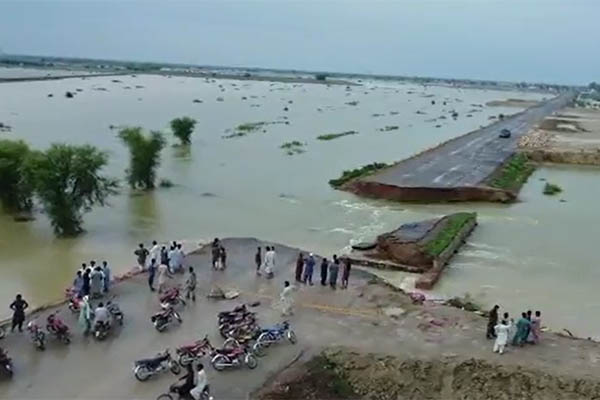
Roads have been washed away by the floods in Sindh
Authorities in Sindh on Sunday started preparing for more flooding in the near future, as the heavy flow of the Indus River barreled down to the province from the country’s north, imperiling locals who had just started to recover from torrential rains that subsided last week.
Talking to the AFP news agency, Aziz Soomro—who supervises the Sukkur Barrage regulating the Indus’ flow—noted the river was currently in high flood, adding authorities feared that once the deluge from the north reached Sindh, already inundated villages could suffer even more devastation. District administration has been endeavoring to evacuate residents of areas most at risk of additional flooding, but resistance persists, especially among locals who fear losing the little property and livestock they have left.
According to officials of the Sindh government, parts of the province are now so inundated, locals have no option but to seek shelter on elevated roads and rail tracks, as their villages are entirely below the water-line.
From north to south
Road access to several parts of Khyber-Pakhtunkhwa remains suspended, as landslides and flash floods have swept away bridges, leaving thousands stranded despite ongoing efforts to evacuate locals to safety. The torrents reached their peak in the Swat River late last week and have since started flowing to the country’s north, passing through Punjab before proceeding toward Sindh and Balochistan.
Rescue teams of the Khyber-Pakhtunkhwa provincial government and the Pakistan Army undertook rescue operations over the weekend, seeking to evacuate stranded tourists from flood-impacted areas in Swat, Dir, and Kohistan. District administrators said 172 tourists were still stranded in Swat’s Asrarit; 150 in Mahodand; and 60 in Bahrain. Similarly, authorities said several families remained stranded in various parts of Balochistan, adding that efforts were underway to either rescue them or provide aid.
In Punjab, authorities warned of flash floods in Mianwali, commencing evacuation operations for residents in low-lying areas. Similarly, they said, the Indus River near already-inundated Rajanpur was once more rising, and there were concerns of a fresh flood in the region.
Casualties still rising
According to the National Disaster Management Authority (NDMA), 1,061 people have died due to rain-related incidents since mid-June, with 28 deaths reported in the past 24 hours alone. Noting that more than 33 million people had been impacted by the floods, it said 31 districts of Balochistan; 6 of Gilgit-Baltistan; 9 of Khyber-Pakhtunkhwa; 3 of Punjab; 23 of Sindh had been declared “calamity-hit.” Total injuries have risen to 1,575, with 1,030 reported from Sindh alone; followed by 307 in Khyber-Pakhtunkhwa; 108 Balochistan; 105 Punjab; 21 Pakistan-administered Kashmir; 4 in Gilgit-Baltistan.
It said floods in Balochistan had blocked or restricted access to road networks of M8 at Wangu Hills; N65 between Karachi and Quetta; N25 at Hub Bridge; N40 from Quetta to Naushki. Meanwhile, in Gilgit-Baltistan, the N140 (Ghizer Road) and the N35 on the Karakorum Highway had been damaged; in Khyber-Pakhtukhwa the N95 from Madyan to Kalam was blocked at 6 points and the N50 was impacted by damage to the Saggu Bridge. In Punjab, the N-55, connecting Fazilpur to Rajanpur was inaccessible.
The disaster relief organization said 692,138 houses had now been partially damaged by the floods, while 300,733 had been completely destroyed. It also updated losses to livestock, saying 727,144 had been reported lost across Pakistan thus far.
Flood warning
The Federal Flood Commission has warned of medium-to-high-level floods in the Indus River for this week. It said river flows at Tarbela had been recorded at 302,000 cusecs; 423,000 cusecs at Kalabagh; 502,000 cusecs at Chashma; and 516,000 cusecs at Taunsa Barrage—well below “very high flood” levels but still at “medium” to “high” levels. Noting the flows were receding in some areas in the north, it warned that this flow was now proceeding downstream, where it could boost flooding in south Punjab and Sindh.
